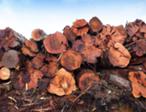Despite an unresolved leak, the Alberta Energy Regulator has given bitumen extractor Canadian Natural Resources Ltd. permission to once again start steaming parts of its Primrose and Wolf project in the Cold Lake Weapons Range.
Last spring, the Primrose operation sprouted mysterious, bitumen-oozing fractures on the ground at four well locations over the sprawling 73,000-hectare project.
From these fissures, more than 12,000 barrels of steamed bitumen has flowed onto muskeg and the forest floor, making the spill one of the largest in Alberta's history.
The spill has raised alarm bells among heavy oil investors. More than half of the bitumen extracted from Alberta's oilsands now comes from costly and energy-intensive thermal operations like the ones at Primrose.
The so-called in situ operations burn natural gas to make steam that melts deep deposits of junk crude. Many have experienced surface casing leaks, but the regulator keeps no dedicated record of such events.
Warns one Ontario-based microseismic monitoring company: "In many cases, operators must be conscious of the rock formations surrounding the reservoir, and need to ensure that the high pressure steam does not induce fractures in a caprock layer or reactivate existing faults or fractures, causing communication with a sensitive layer (i.e. an aquifer) or in the case of shallow operations, the surface."
CNRL employs a process known as cyclic steam stimulation that injects high volumes of steam into 500-metre deep bitumen formations.
This form of fluid injection, which behaves much like hydraulic fracturing, typically heaves the ground by as much as 36 centimetres over the course of a month.
Steaming restrictions imposed by the regulator in 2013 remain in place at Primrose East and within one kilometre of the well pad leak at Primrose South.
"The [regulator] understands that Albertans are concerned about operations at Primrose and Wolf Lake. While we don't generally announce project approvals outside of hearing processes, after reviewing concerns submitted by several stakeholders, we want to ensure transparency is upheld," Alberta Energy Regulator CEO Jim Ellis said in a statement.
In a March update on its website,, CNRL said that it hopes to "locate and delineate" how bitumen flowed to the surface from the Clearwater formation, and identify "the root cause(s) of the flow to surface" of nearly 12,000 barrels of steamed bitumen.
To date, the Calgary-based company has spent more than $40 million in cleanup operations that have involved the removal of approximately 70,000 tonnes of earth.
It also pumped 404,378 cubic metres of water out of a small unnamed lake to clean up two seeping bitumen fissures.
Mike Hudema, a Greenpeace energy and climate change campaigner, characterized the decision to allow steaming at the project as irresponsible.
"It's unbelievable that the AER would allow CNRL to start injecting high-pressure steam within 1.5 kilometres of where bitumen is still leaking into a lake. The AER needs to reverse its decision and reject all new steaming applications until its investigation is complete, the spills are stopped, and solutions to prevent them are fully identified."
Since 2001, satellite imagery has been used by industry to monitor the progress of steam injection and detect ground deformation. The imagery can also help industry determine "whether linear features exist at the surface that may indicate the presence of weaknesses in the subsurface, such as fractures or even faults."
Secret federal briefing notes obtained by Postmedia reporter Jason Fekete earlier this year show that the government knew about satellite data that showed ground level deformation in the area from 2009 to 2013.
Fekete reported that the satellite data showed that "the values of ground deformation (both subsidence and uplift) at the CNRL operation were often in the range of 10 to 30 centimetres over various sampled 24-day periods." Such data indicates that CNRL may have injected too much steam into the formation.
Many scientists now fear that continuous lifting and dropping of the earth combined with the force of injection near local faults and abandoned wells could fracture holes in the caprock, leading to extensive groundwater pollution and surface bitumen leaks.
A significant spill by CNRL at the same project still seeping bitumen occurred in 2009 and contaminated groundwater. The regulator did not report on that event until 2013, four years later.
A recent report on the chaotic nature of the spill response by two scientists, Peter Lee and Kevin Timoney, criticized the regulator and CNRL for their lack of transparency.
The regulator, which is 100 percent funded by industry, has offered virtually no information on the seepage event or the investigation of its causes.
"The regulator's inability to determine the causes of previous caprock failures while allowing high pressure cyclic steam operations to continue in the absence of improved safeguards has imposed unquantified risks to bitumen resources, groundwater and adjacent ecosystems," concluded the scientists' report.
Bitumen steam plants have encountered other challenges including sour gas releases, extreme greenhouse gas emissions, chronic underproduction and dismal energy returns on par with biofuels.
The regulator abruptly suspended shallow bitumen production around Fort McMurray last January due to concerns about fracturing the region's caprock. The suspension impacted several billion-dollars worth of projects.
The regulator announced the freeze on development in the Wabiskaw-McMurray deposit of the Athabasca oilsands area while it completes "a thorough technical review of the factors that affect reservoir containment of steam-assisted gravity drainage (SAGD) projects."
Andrew Nikiforuk is an award-winning journalist who has been writing about the energy industry for two decades and is a contributing editor to The Tyee.










What have we missed? What do you think? We want to know. Comment below. Keep in mind:
Do:
Do not: